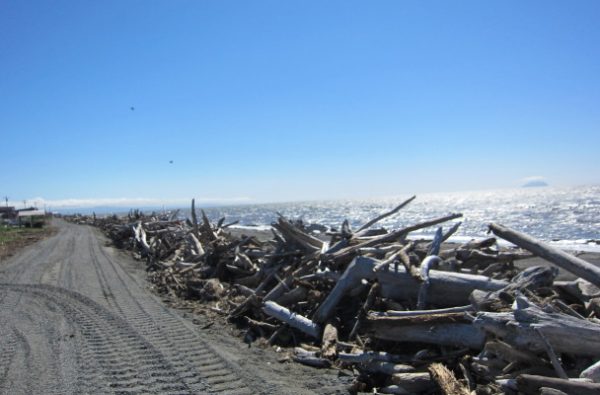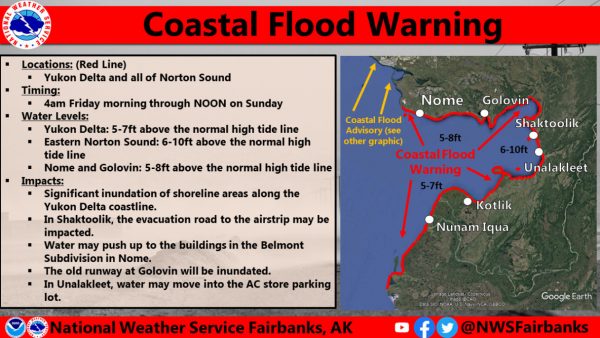
Several communities in the Norton Sound region experienced coastal flooding over the weekend, although the high water didn’t do as much damage as originally forecast. Coastal flooding occurs when dry land is submerged under ocean water.
According to coastal flood warnings from the National Weather Service, the water level was forecast to rise five to eight feet above the high tide line in Nome, but six to 10 feet in Unalakleet with flooding in specific low-lying areas. Staff at the city office in Unalakleet say high water did go over the road on Saturday but did not flood the local grocery store parking lot as NWS expected.
According to NOAA’s tide gauges, water levels reached nine feet in Unalakleet, whereas Nome’s highest over the weekend was about four feet.

Rick Thoman, a climatologist with the Alaska Center for Climate Assessment and Policy (ACCAP), highlights the fact that different communities, especially in the Norton Sound, won’t necessarily experience the same intensity from the same coastal flooding event. That’s due to a variety of complex reasons, Thoman says, but one is the exact trajectory of the water as it pushes onshore.
“And another factor is also the tides, tides around Norton Sound are extremely complex and the timing of the highest push of water from the storm, when that coincides with high tide, you can get a significant flood event,” he said. “If the exact same push of water comes at a particularly low tide, may not be so much problems.”
Meanwhile in Shaktoolik — another Eastern Norton Sound community — this past weekend, NWS had originally forecast the possibility of Shaktoolik’s only evacuation road being impacted by coastal flooding.
However, according to the NWS office in Fairbanks, residents from Shaktoolik only reported high water in the community, and no actual flooding or coastal erosion. Sophia Katchatag, the community coordinator with the Native Village of Shaktoolik, did not respond for comment before the airing of this story.
None of the impacted communities reported significant erosion from these coastal flooding events, however that has happened in places like Diomede and Kotlik in recent years. As there is now a standard of less sea ice in the Norton Sound region compared to years past, Thoman says the length of the coastal flooding season can extend into February.
“Thirty years ago, we really thought about coastal flooding as the September, October for Norton Sound, maybe into early November but after that sea ice was there and it became much less of a threat,” he said. “We know that’s no longer the case, and this is something we have to be concerned about year-round.”
Thoman added that these coastal flooding events may not get more intense or cause more damage in Western Alaska, but if sea ice coverage continues to diminish then the number of damaging storms will likely increase.
The NWS Fairbanks office says rain showers are expected to continue off and on this week in Nome and other parts of the region, with a potential for more coastal flood warnings during the next few days.
Davis Hovey is a news reporter at KNOM - Nome.
Hovey was born and raised in Virginia. He spent most of his childhood in Greene County 20 minutes outside of Charlottesville where University of Virginia is located.
Hovis was drawn in by the opportunity to work for a radio station in a remote, unique place like Nome Alaska. Hovis went to Syracuse University, where he graduated with a Bachelor’s of Science in Broadcast Digital Journalism.




